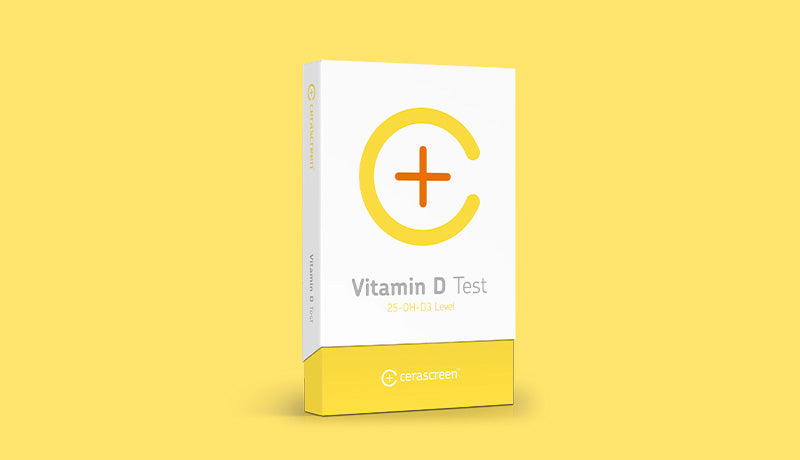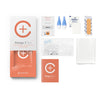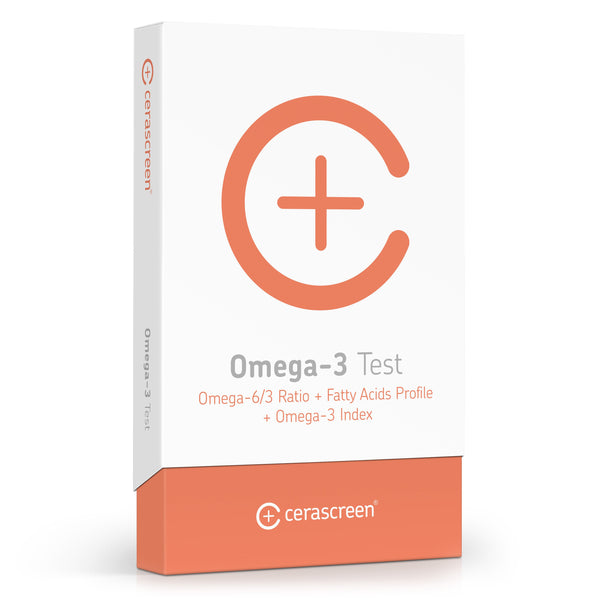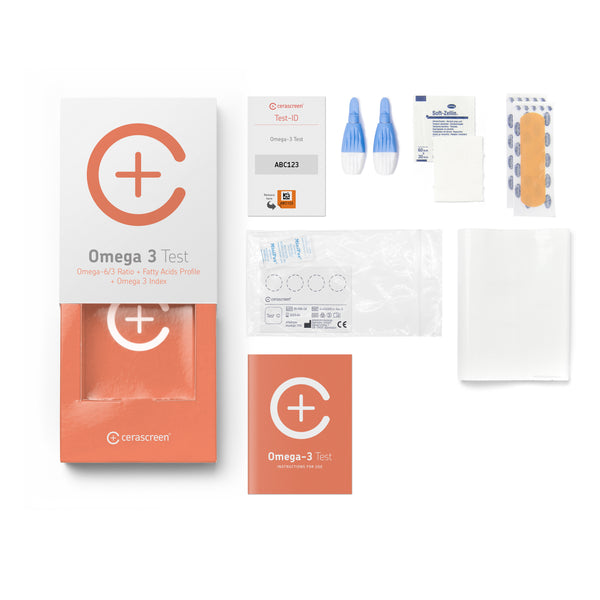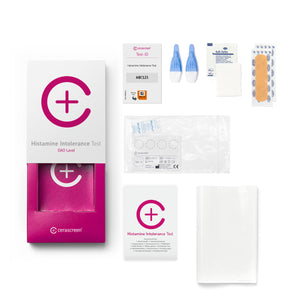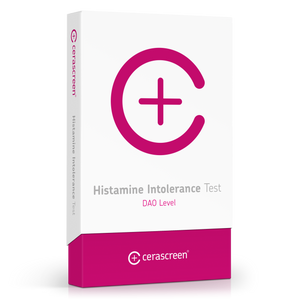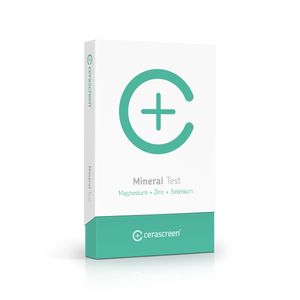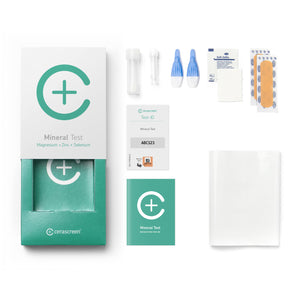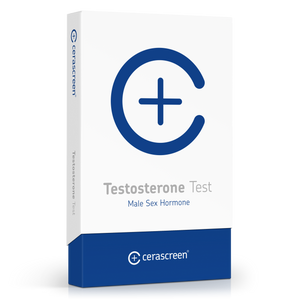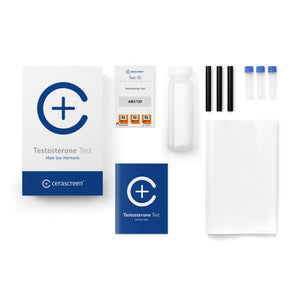product_id = 2321984847931variant_id = 21329307435067template_name =
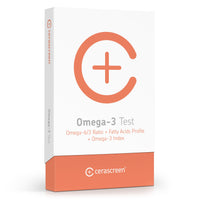
Omega-3 Test
About the test
The cerascreen® Omega-3 Test is a home test kit that allows you to analyse the composition of fatty acids in your blood. Our partner medical laboratory determines your omega-3 index and the ratio of omega-3 to omega-6 fatty acids in your blood.
Omega-3 fatty acids are considered particularly healthy fats. But with our modern diets, we actually consume very little omega 3. This can become a problem – if we take in more omega 6 than omega 3, our body is at risk of inflammation and cardiovascular disease.
Omega-3 Test
- Take your sample at home – conveniently and discreetly
- Receive a state-of-the-art laboratory analysis
- Get a breakdown of your fatty acids
- Benefit from specific recommendations on nutrition and your diet
- Receive the result within a few days after your sample’s arrival at the laboratory
Benefits of the Omega-3 Test
Omega-3 fatty acids prevent inflammation in the body; omega-6 fatty acids, on the other hand, promote it. Together, they help maintain low levels of inflammation in our bodies. A ratio of omega 6 to omega 3 of no more than 5:1 is recommended – but most people in Europe tend to have a ratio of 15:1 – as their diet comprises too much omega 6 and not enough omega 3.
A good ratio of omega 6 to omega 3 is said to have a positive effect on blood vessels, the immune system and the distribution of nutrients in the body. So, if you know the composition of fatty acids in your body and you manage to keep the ratio optimal, you will boost your cardiovascular health and your immune system.
Benefit from our expertise: cerascreen® is the market leader for medical home test kits in Europe, with eight years of experience in test development and analysis. We have developed more than 50 approved send-in test kits (medical devices), analysed 250,000 samples and serve 19 countries.
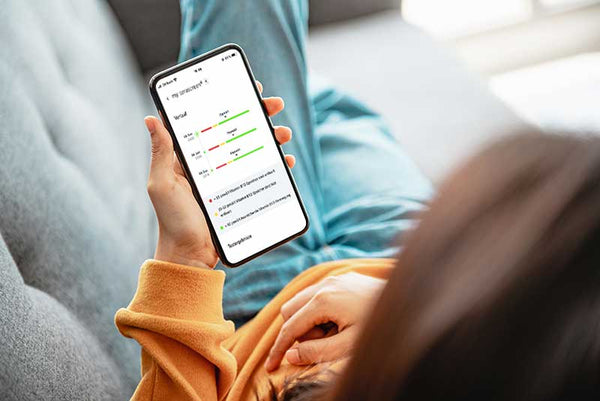
Result of the Omega-3 Test
As soon as your sample has been analysed, you will receive your results report via the My cerascreen® app or your user account on our website. You can easily view the report on your smartphone, tablet or computer and print it out, if required.
Learn about the ratio of omega 6 to omega 3 in your laboratory analysis. Learn how to improve your omega-3 index through diet and supplements with concrete recommendations for action. You will receive extensive health information, in which we go into detail about the connection between fatty acids and health.
Frequently asked questions about Omega-3 Test
Why should I test my omega-3 levels?
Omega 3 is an umbrella term for a range of polyunsaturated fatty acids that we consume through food and that the body needs for different purposes. Among other things, omega-3 fatty acids are important for our heart health, blood vessels and for our immune system.
With a test, you can find out whether the ratio of fatty acids in your body is healthy.
Who should take the Omega-3 Test?
Most people in the Western world would benefit from an analysis of their unsaturated fatty acids. It is estimated that our average ratio of omega 6 to omega 3 in Europe is 15 to 1, but a ratio of no more than 5 to 1 is recommended. This means that most people don’t consume nearly enough omega-3 fatty acids.
There are also some risk groups for omega-3 deficiency. The risk groups include vegetarians, vegans, older people, pregnant women and generally people who do not eat fish.
What are omega-3 fatty acids?
Omega-3 fatty acids dilate our blood vessels and have an anti-inflammatory effect. Omega-6 fatty acids, on the other hand, promote inflammation and have a vasoconstrictive effect. If you strike the perfect balance between both types of fatty acids, you can optimise your inflammation levels, thereby boosting your health. Experts recommend aiming for an omega ratio of at least 5 to 1.
How long does the analysis take in the laboratory?
Once your sample has arrived at the laboratory, it will be analyzed there by specialists. How long the analysis takes depends on the exact measuring method and the processes in the laboratory.
If the sample is sent on the correct days (Sunday to Tuesday), this makes it easier for the laboratory to adhere to the times.
For the Omega-3 Test, the laboratory analysis is usually completed within 5 working days after the sample is received in the laboratory.
How does the test work?
For the Omega-3 Test, you take a small blood sample from your fingertip using a lancet. The sample is sent on a dry blood card by return envelope to our specialised medical laboratory, which analyses the composition of fatty acids in your blood. The laboratory determines your omega-3 index and the ratio of omega 6 and omega 3.
What will the results tell me?
The result report tells you your omega-3 index and the ratio of omega 6 to omega 3 in your blood.
The omega-3 index describes the proportion of the two omega-3 fatty acids EPA and DHA in the total fatty acid content in your blood. A value of four to eleven per cent is recommended. If your omega-3 index is below this value, you should consume more omega-3 fatty acids.
The ratio of omega-6 to omega-3 should be between 1 to 1 and 6 to 1. If the value is higher, you are consuming too many omega-6 fatty acids compared with omega-3 fatty acids. This means that you might have to change or adjust your diet.
The results report gives you recommendations on how to reduce the ratio of omega 6 to omega 3 to a value of 5 to 1 or lower. This includes tips on how to change your diet to get the right amount of unsaturated fatty acids and how to take omega-3 supplements.
How do I know I am deficient in omega 3?
If the amount of omega-3 in your body is too low, this can lead to constricted blood vessels, inflammation and a weakened immune system.
Possible symptoms of an omega-3 deficiency include:
- Fatigue and muscle weakness
- Poor memory and depression
- Poor eyesight
- Higher risk of high blood pressure and heart disease
- Higher risk of infections
- Dry skin
Why do I need omega 3?
According to studies, omega-3 fatty acids promote health on several levels. Among other things, good omega-3 levels lower cholesterol levels and reduce blood clotting and inflammation in the body. Omega-3 fatty acids are said to help boost mental performance and eyesight in old age.
The roles of omega-3 fatty acids in the body also include:
- Strengthening the immune system
- Lowering blood pressure
- Cell metabolism
- Formation of protein
- Reducing oxidative stress in cells
Which foods contain omega 3?
Our body cannot produce omega-3 fatty acids itself. We have to take them in through food. The best source of omega 3 is fatty fish such as salmon, mackerel, herring, tuna and sardines. The World Health Organization (WHO) recommends eating fish once or twice a week to meet your omega-3 requirements.
Plant-based foods usually contain significantly more omega 6 than omega 3, which means that vegetarians, vegans and people who don’t eat fish for other reasons often develop a fatty-acid imbalance.
However, there are some plant foods that contain larger amounts of omega 3:
- Linseed oil
- Rapeseed oil
- Chia seeds
- Walnuts
If you do not manage to get enough omega 3 through your diet, you can also opt to take dietary supplements. These are usually capsules or oils and, in the best case, contain an active form of omega 3. Many are based on fish oil, but there are also vegan omega-3 supplements, usually made with algae oil.
How much omega 3 does my body need?
Some of the major international health organisations, such as the World Health Organization (WHO) and the European Food Safety Authority (EFSA), recommend a daily intake of at least 250 milligrammes of omega-3 fatty acids so that the fatty acids can fulfil their basic functions, such as maintaining heart function. However, according to WHO and EFSA, two grammes of omega 3 or more is better.
The US National Institutes of Health breaks down its recommendations by age and gender. Accordingly, adult men should consume 1,600 milligrammes of omega-3 fatty acids, adult women 1,100 milligrammes.
Can I overdose on omega 3?
Health experts warn that too much omega 3 can lead to increased cholesterol levels and a weakened immune system, especially in older people. An overdose is hardly possible through our diet; you’d have to overdose on high-dose omega-3 supplements.
That is why it is probably sensible not to simply start taking supplements. A test like the cerascreen® Omega-3 Test provides you with clarity about your omega-3 levels – and allows you to optimise your levels, if necessary. If your values are too low, fish oil or algae oil capsules with omega 3 can be useful.
Why are children under 18 not allowed to take the test?
Our tests are not suitable for underage children and adolescents under the age of 18. Under 18s cannot activate the tests online and therefore cannot receive a test result. We ask that you do not administer the tests to your children either.
Children and adolescents need much closer supervision and counselling regarding medical tests and their interpretation. Testing with lancets and chemicals is not without risk and would need to be closely supervised by guardians. In addition, the reference values we give are always based on adult data. In the case of children, the risk of misinterpreting the results would be very high.
We want to fulfil our responsibility as a provider of medical products and ensure that children and adolescents are not unsettled by measurement results that are difficult for them to interpret. Since we cannot control whether the minors' legal guardians actually consent to the test being carried out and supervise them, we exclude tests for under 18s altogether.
If you are under 18 and have purchased a test, please contact our customer support.
Why does it take up to a week for the sample to reach the lab?
Please bear in mind that your results will not be analyzed in the UK but in Germany. For that reason, it can take up to a week for the sample to arrive at the lab. This does not affect the stability of the samples, as the method we are using is optimized for long transports.
Initially, your sample is sent to our collection center in the UK. From there, it is shipped to our central sample sorting facility in Germany, which then distributes samples to our partner laboratories. Once your sample is analyzed there, you will receive a notification and can access your result online.
Please check your mailbox regularly. We will notify you as soon as your sample is sent, arrives, or is analyzed.
Why does the test have an expiration date?
The cerascreen® test kits are CE-marked medical devices, which in turn include other certified medical components such as lancets, patches, and alcohol swabs used in blood tests.
Like most medical devices, these components have an expiration date to ensure that they remain safe and effective. Many of our sample carriers – such as dried blood cards or sample tubes – are chemically treated to keep your sample stable and analyzable in our laboratory. Over time, environmental factors can affect this treatment and compromise accuracy.
Our sterile, single-use lancets also carry an expiration date to guarantee sterility and safe use up to that time.
This is how it works
1. Test at home
Your test kit contains everything you need to draw a small sample of blood from your fingertip. Then send the sample back to us free of charge in the enclosed return envelope.
2. View results online
After the evaluation in the medical specialist laboratory, you will have online access to your personal result report.
3. Act
Your access to the test results and the evidence-based findings and tips to improve your health: the my cerascreen® user profile on our website or our app.

